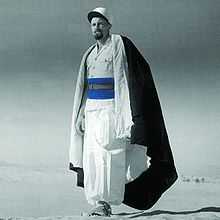Méhariste

Méhariste is a French word that roughly translates to camel cavalry. The word is most commonly used as a designation of military units.
Origins of French Camel Corps
France created a méhariste camel corps as part of the Armée d'Afrique in the Sahara in 1902, replacing regular units of Algerian spahis and tirailleurs earlier used to patrol the desert boundaries. The newly raised Compagnies Méharistes were originally recruited mainly from the Chaamba nomadic tribe and commanded by officers of the French Affaires Indigènes (Native Affairs Bureau). Each company of Méharistes comprised six officers, 36 French non-commissioned officers and troopers, and 300 Chaamba troopers. Their bases were at Tabelbala, Adrar, Ouargla, Fort Polignac and Tamanrasset.
History
With their local tribal links plus mobility and flexible tactics, the Compagnies Méharistes provided an effective means of policing the desert. A similar camel corps was subsequently raised to cover the southern Sahara, operating from French West Africa and falling within the Armee Coloniale. From the 1930s onwards the Meharistes formed part of the Compagnies Sahariennes which also included motorised French and (from 1940) Foreign Legion units. Following the establishment of a French Mandate over Syria in 1920, three mehariste companies were organised in that country as part of the French Army of the Levant.
During World War II Mehariste companies organised as "nomad groups" saw service against Axis forces in the Fezzan and southern Tunisia.
At the end of the war the Compagnies Sahariennes resumed their role as desert police. The Sahara remained relatively quiet during the Algerian War of Independence (1954–62) but there was one instance, on 17 October 1957, where 60 meharistes near Timimoun mutinied and killed their eight French officers. According to differing reports the mutineers either were able to join the rebel ALN or were caught in the open desert by French fighter aircraft and destroyed.
The camel mounted units were retained in service until the end of French rule in 1962. The locally recruited meharistes were then disbanded while French personnel were transferred to other units.
Spanish and Italian Camel Corps
Locally recruited camel corps were also maintained by the Spanish and Italian armies in their respective North African territories (Spanish Sahara plus Cyrenaica and Tripolitania) during the colonial period. Both the Spanish Tropas Nomadas and the Italian Zaptie Meharista served primarily as desert gendarmerie. Like their French counterparts they were recruited from the indigenous desert tribes and wore modified versions of tribal dress.
Post-independence
The modern Algerian army maintains up to twelve companies of desert troops in the Sahara but these are mechanised units. According to recent media reports the government of Mali is considering the creation of a camel mounted unit for patrol and policing work along its Saharan border.
Uniform
The Compagnies Meharistes wore flowing coats (gandourah) of either white for Arab or blue for Tuareg troopers, with turbans, veils and wide black trousers (seroual). Two red sashes were worn - one wound around the waist and the other crossed on the chest under red-brown leather equipment of traditional Saharean pattern. A khaki field dress of similar cut was also worn.
French personnel wore light blue kepis. All ranks were normally bare-footed when in the saddle, in order not to harm the sensitive upper body of their camels. The saddlery and other leather equipment was of local design and often elaborately decorated.
See also
- Tropas Nómadas - The Spanish Army equivalent in Spanish Sahara.
- Tirailleurs - Colonial infantry used in the French Army.
- Camel cavalry
- French colonial flags
- French Colonial Empire
- List of French possessions and colonies
References
- (French) The Mehariste
- "L'Armee D'Afrique 1830-1962" C.R. Hure 1977
- "The Conquest of the Sahara" Douglas Porch ISBN 0-394-53086-1
- "Le Uniformi Coloniali Libiche 1912-1942" Piero Crociani. La Roccia 1980
- "Uniformes Militares de la Guerra Civil Espanola" Jose Bueno. Libreria Editorial San Martin Madrid 1971